The photograph at the top of this page (by E.J.Peiker) is my favourite picture of a Java Sparrow. I have spent many hours on the Internet looking for pictures of this great bird but I haven't found one that captures the colour and beauty in full sunlight as this photo illustrates. For me, this is the perfect example of my favourite bird and has prompted me to specialise in breeding the normal / wild type
Java Sparrow
I refer to the Java Sparrow in past tense as it was formerly widespread and abundant in its native range, but numbers have crashed disastrously. It is now difficult to find in these areas and is now listed on CITES Appendix II.
What does this mean
Well...CITES (the Convention on International Trade in Endangered Species of Wild Fauna and Flora) is an international agreement between governments. Its aim is to ensure that international trade in specimens of wild animals and plants does not threaten their survival. The species that CITES covers are listed on three appendices, according to the degree of protection they need.
Appendix I includes species threatened with extinction. Trade in specimens of these species is permitted only in exceptional circumstances.
Appendix II includes species not necessarily threatened with extinction, but in which trade must be controlled in order to avoid utilization incompatible with their survival.
Appendix III contains species that are protected in at least one country, which has asked other CITES Parties for assistance in controlling the trade. Changes to Appendix III follow a distinct procedure from changes to Appendices I and II, as each Party’s is entitled to make unilateral amendments to it.
(The information about CITES was taken from their web site, for more comprehensiveClick Here to visit their web site).
The decline of the wild Java Sparrow, in a strange twist of irony, is due to the domestic and international cage-bird trade. It has been a popular bird in aviculture for some fifty years or so and the trapping of the wild Java's has had a huge effect on the wild population
It is gregarious by nature, especially outside the breeding season, and can often be seen with large flocks of its own kind, particularly in paddy fields where they are seen as vermin due to their ability to devour rice crops. In fact, their fondness of rice has influenced their alternative name, Rice Finch, Rice Munia....and even its latin names, Lonchura Oryzivora and Padda Oryzivora, link the bird with rice (Oryzivora is latin for rice).
Java sparrow in the wild
As it's name suggests, the Java Sparrow originated from Java, one of the largest Indonesian islands.
It was widespread across Sumatra, Bali and many of the Indonesian terrortories. It then became more prevalent in Malaysia, Borneo and the Philippines.I refer to the Java Sparrow in past tense as it was formerly widespread and abundant in its native range, but numbers have crashed disastrously. It is now difficult to find in these areas and is now listed on CITES Appendix II.
What does this mean
Well...CITES (the Convention on International Trade in Endangered Species of Wild Fauna and Flora) is an international agreement between governments. Its aim is to ensure that international trade in specimens of wild animals and plants does not threaten their survival. The species that CITES covers are listed on three appendices, according to the degree of protection they need.
Appendix I includes species threatened with extinction. Trade in specimens of these species is permitted only in exceptional circumstances.
Appendix II includes species not necessarily threatened with extinction, but in which trade must be controlled in order to avoid utilization incompatible with their survival.
Appendix III contains species that are protected in at least one country, which has asked other CITES Parties for assistance in controlling the trade. Changes to Appendix III follow a distinct procedure from changes to Appendices I and II, as each Party’s is entitled to make unilateral amendments to it.
(The information about CITES was taken from their web site, for more comprehensiveClick Here to visit their web site).
The decline of the wild Java Sparrow, in a strange twist of irony, is due to the domestic and international cage-bird trade. It has been a popular bird in aviculture for some fifty years or so and the trapping of the wild Java's has had a huge effect on the wild population
Natural habitat
The Java Sparrow is usually a lowland species, predominantly found below 500 m but occurring locally up to 1,500 m. It has been recorded in many habitats, including towns and villages, cultivated land, grassland, open woodland, tree savanna, beach forest and even mangroves.It is gregarious by nature, especially outside the breeding season, and can often be seen with large flocks of its own kind, particularly in paddy fields where they are seen as vermin due to their ability to devour rice crops. In fact, their fondness of rice has influenced their alternative name, Rice Finch, Rice Munia....and even its latin names, Lonchura Oryzivora and Padda Oryzivora, link the bird with rice (Oryzivora is latin for rice).




